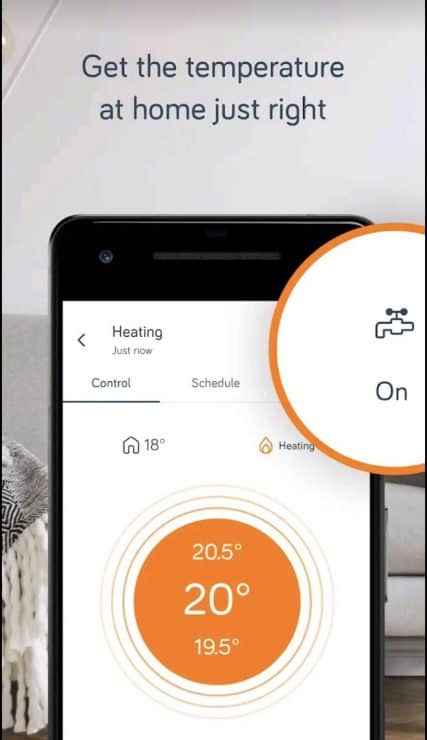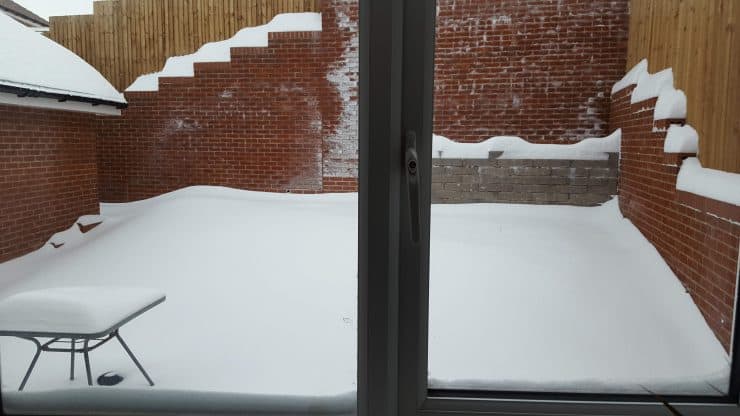“My smart thermostat has really improved my home life” – said no one ever.
When smart ‘learning’ thermostats burst onto the scene in 2011, they did so to great fanfare. After all, they are smart. They learn. They will massively improve your home life… or so the marketing promised.
The reality is a lot more mundane: they take an hour or two to install (assuming you are competent to install it yourself) and they cost a decent amount of money to buy in the first place. Once installed, you play with the thermostat app a bit over the first week, and then forget about it.
Whilst there are some positives to smart thermostats, I wanted to be extra grumpy and explain 11 real reasons why smart thermostats are kind of pointless. You can watch the video version of this article below:
If you prefer text, or you want some extra detail on some of the points that I raised, then please read on!
Smart Thermostats Are Expensive Compared To The Cost Savings

The Nest Learning Thermostat currently sells for over $200, and then getting a professional to install it will usually be $80 or more. That’s almost $300 spent on your thermostat right away, but will you recoup this investment quickly?
Well, Nest claim that 10-12% is saved on heating and 15% on cooling costs, leading to savings of $131 to $145 each year. This means that your smart thermostat pays for itself after two and a half years (or less than two years if you install it yourself).
That’s not too bad, assuming that you get the full cost savings that Nest claim. Of course, depending on your local climate and house construction type, you might save less than $131-$145 per year and then your pay-off period will be three of more years.
Equally if you had a new heating system installed in the last couple of decades, you probably already have a programmable thermostat (just not a ‘smart’ one). If you have set this up correctly, then unfortunately your cost savings with a smart thermostat will be minimal – if anything at all. In this case, the pay-off period will be measure in decades instead of years.
Radiator Valves: you might also have thermostatic valves fitted to your radiators, which can actually save you even more money than a smart thermostat can. This is because a thermostat can only provide house-by-house (or zone-by-zone) level control, compared to valves which can provide room-by-room control – meaning that you don’t heat rooms that no-one occupies.
They Can Be Hard To Install
If you have a fairly modern heating system with a fairly modern wall-mounted thermostat, installing the Nest will probably be fairly straightforward. Of course, we should add that it’ll be straightforward for people who like DIY and are fairly good at electrics. Google’s own Nest install guide does openly talk about wiring diagrams and the need to turn off your power/guard against high voltage cables.
If you don’t like the sound of this, unfortunately you might struggle to install your smart thermostat. There are a lot of videos online showing how to install it, of course, but you do need to be moderately capable at DIY, electrics and then gadgets (to actually setup the thermostat and mobile phone app).
In rare cases (or with much older heating systems), you might also find that you need to run extra cables to the boiler – or make a change to the boiler side before Nest will work. This is thankfully not too common because Nest (and other smart thermostats) are built to be compatible with a wide range of heating systems, but this could make your install more complicated (and expensive).
Constantly-Changing Temperatures Can Be BAD For Your House

Part of the point of smart thermostats is that they know when you’re likely to be out of the house, and will set the temperature to be lower. This sounds great, right? After all, why should you pay to literally heat an empty home? Well this is definitely a valid argument, however if the temperature becomes too low, it can lead to condensation and damp/mold build-up.
This might take the form of visible mold (in which case you can adjust the thermostat’s settings), but airborne mold is possible and inhaling this can be bad for your health – leading to a range of respiratory problems.
Naturally, smart thermostats do take steps to prevent this and they won’t simply set the ‘low’ temperature point to be freezing cold. It’ll be set to a fairly sensible setting for your local climate.
However, some houses generally struggle with damp issues for a range of reasons:
- Poor ventilation.
- Having too much insulation.
- Not having enough insulation!
- Having drafts come in through doors or windows
- … or a dozen other reasons.
A smart thermostat cannot know this in advance, meaning that it might set the temperature to a sensible value for most houses in your area, but it’ll still be an incorrectly low temperature for your particular house.
Too Late? You might not notice any issues with mold or damp at first, but these problems can sometimes build up over time. You might think that your smart thermostat is saving you money – but you won’t think this if you get hit by a big mold/damp remediation bill later on!
As a final point, it’s easy to forget pets. You should make sure that your ‘away from home’ temperature is high enough to be suitably comfortable for your pets (at least 60°F/16°C). But it is easy to forget, especially if you get a pet after your smart thermostat system has been installed. And your pets won’t be able to tell you that they were freezing their butts off at 10am whilst you were at work!
The ‘Learning’ Is Good… But Not Great

One of the key selling points of smart thermostats is that they learn. If you wake-up daily at 6am to eat breakfast and keep raising the temperature of the thermostat to 70°F/21°, it will learn that you like it at this temperature (at this time) and pre-program itself in the future.
It will also start learning when you come home from work and go to bed, and ensure that your desired temperature is set then.
This is great, apart from the fact that people’s routines aren’t always fixed – especially in a household with multiple adults and children, all of whom might like slightly different temperatures! In this case, you might get ‘thermostat war’ where people are changing the temperature to suit their own needs (as has happened for decades, ever since thermostats first came out!).
People’s routines have also never been busier due to the demands of modern-day life, with the British Heart Foundation reporting a rise in parents who are concerned at their (lack of) free time to spend with their children.
While the demands of modern life isn’t directly relevant to smart thermostats, I would argue that ever-changing household routines mean that many households would be better off with a simple multi-zone programmable (non-wifi) thermostat.
Motion Detection Can Be Unreliable
Nest has ‘Auto Away’, while ecobee has ‘Smart Away’. These features use sensors and/or the GPS on mobile apps to detect when the last person has left the house and adjust the heating accordingly. This is perfect for those days when you all need to learn for business meetings (or school trip runs) an hour or two earlier than usual. And this feature does actually work quite well overall… a rare bit of positivity from me in this article!
However, they don’t work perfectly. The sensors are wide angle to detect smaller children too, however they can sometimes detect large pets by mistake. In this case, your ‘smart’ thermostat will think that an adult is in the house and turn the heating fully on. Great.
To help guard against this, you can set Home/Away/Assist to use your phone’s GPS location instead. This is a nice feature, however this can become buggy, because:
- You might forgot to leave GPS (location) on.
- You get a new phone and install the app there (I’ve seen cases where this makes Nestthink that an extra adult is in the house, as the old phone – with the app still installed – is still in the house).
- Your phone has power saving mode on, which can often stop this feature working.
In short, be sure to double check your app quickly when you’re away from the house, just to check that the app doesn’t think there’s someone at home – burning extra gas for no reason.
They Are Gimmicky And Often Not Needed

Smart thermostats are a ‘wow factor’ gimmick that aren’t needed in the majority of cases. There, I said it. Phew, I feel unburdened.
Okay, so unless you have an ancient thermostat or are too lazy busy to spend 30 seconds programming your existing thermostat, you really won’t benefit all that much from a super duper smart thermostat.
After all, how smart does your thermostat need to be? The standard house’s usecase for their home temperature is simple:
- When at home in the morning/evening (usually based on the time of day), set a fairly high ‘cosy’ temperature.
- When away from home during the day (usually based on the time of day), set a fairly low temperature.
- When at home overnight/sleeping (usually based on the time of day), set a fairly low temperature.
That’s it. Simple. You can set this up quickly with a standard thermostat. In other words, an all-singing-all-dancing ‘smart’ thermostat which blows a $250 hole in your wallet probably isn’t needed.
Yes the smart thermostat looks cool on the wall, but so does a nice family picture or piece of art from HomeDepot – and they will cost a lot less than $250.
They’re Confusing To People Who Aren’t Tech Savvy

I sort of don’t want to make this point on this website, a website dedicated to techy people and techy gadgets. But, the reality is that some people find smart thermostats confusing. They aren’t as easy to change the temperature as a standard thermostat.
I know it seems as easy as plugging in a mouse to us techy folk, but new technology scares people who aren’t as clued up on gadgets.
So if you have a relative coming to stay who isn’t tech savvy, they might struggle to change the temperature when you aren’t around. This could mean them being uncomfortable in their own (temporary) home.
Equally if you move house but leave the smart thermostat behind, the new homeowners might not understand or appreciate the smart thermostat.
You Can’t Always Take It With You When You Move

A smart thermostat is fixed to the wall, and also wired in. When you move house, you might have to leave it behind (unless you agree that you’ll be taking it during the house sale). This isn’t great if you spent $300 for the device and installation a year or two ago: you will be moving house before it has paid for itself, and then the new owners will reap all the benefits. A lose-lose for you!
Equally, lodgers and renters will often be unable to install a smart thermostat. This seems harsh on a large group of the population who might want to get some of the convenience and cost savings of a smart thermostat, but are not allowed to install them based on their rental agreements.
Tip: When you do move house, you will need to deregister the smart thermostat from its app. Failure to do this will mean that the new homeowners will be unable to register and use the device for themselves – leading to phone calls and extra stress after a house sale.
I guess the conclusion here is that if you are planning on moving house anytime soon, you might want to re-consider installing hardwired or drilled-in smart devices.
Multi-Zone Setups Can Get Expensive

We mention earlier that if you have a busy house life, everyone might want to set different (contradictory) temperatures. The solution to this is a multi-zone heating setup.
This is a really nice solution for a modern family, because the playroom and children’s bedrooms could be one temperature (I’m thinking a tropical 75 °F/24°C ?!), the main living room could be another temperature and the kitchen/bathrooms might be another.
This sounds great and it does work well, however it can get expensive because each ‘zone’ is driven by a separate thermostat (otherwise the thermostat can’t know the ambient temperature for monitoring and regulating purposes). If you want three zones, that’s 3x$200 = $600 for three Nest thermostats. You won’t get much change of a grand if you also pay someone to install them.
Will this really save you money, especially if one (or more) of the zones are set to very high temperatures (“because I like it this warm”)? I doubt it.
Yes you can mix-and-match smart thermostats in with ordinary ones (i.e. having a Nest thermostat in one zone, and the normal thermostats in the other). But, this sort of defeats the object of having smart thermostats: since they are meant to learn all of your house’s routines and energy use, not just one part of it.
Software Bugs Can Result In Cold Houses!

We’ve all seem enough futuristic and dystopian movies to know that technology can go rouge and murder (or at least mildly maim) everyone, right? Okay, maybe I’m watching different movies to the rest of you, but technology can fail. Whether it’s Windows crashing right before a work presentation, or the keyword of your $3k Macbook Pro being dodgy.
Equally, smart thermostats can fail due to software bugs – leaving the house occupants cold (not once, but multiple times). You would think that smart thermostats would fall back to being ‘dumb’ basic thermostats if they fail, but that’s not the cast.
After all, they’re designed to control everything. If they have a software (or hardware) bug, they obviously won’t know this and so they will act unexpectedly. This might mean too much or little heat, or weird humidity/climate settings.
Occasional software bugs are understandable and are fine to put up with for really useful technology, but do you really need to put up with them for a smart thermostat?
Your House’s Data Is Sold To Advertisers: Yay!
Everyone loves when their data is sold to advertisers, right? Wait, what do you mean that you don’t?
Well some smart thermostat providers have been known to harvest your house’s heating/climate data and sell this to advertisers and other companies. For example the New York Times report that Kinsa sold data to health companies so that they could find out which parts of the country have increased fever. The health companies then directed targeted adverts to those areas for things like disinfecting wipes. Creepy.
Nest originally had plans to ‘share’ (i.e. sell) energy usage data with energy firms and the situation doesn’t sound much better now that Nest are owned by Google (since Google are… well… Google). They are known to take liberties when it comes to people’s personal data – especially when it comes to using it for advertising. That’s why after viewing a product on Amazon, the internet is suddenly full of Google-powered adverts for that specific product.
So do Nest/Google sell your personal data? Well their privacy policy in both the US and UK says the following:
“Under no circumstance do we share personal information for any commercial or marketing purpose unrelated to the activation and delivery of Nest Products and services without asking you first. Period. We do not rent or sell our customer lists.”
Nest Privacy Policy, accessed April 2023, drafted by Nest in January 2020
Which is sort of promising, although the “without asking you first” part means that they can share your personal data if you permit it. In other words, double check your marketing preferences – either via the app, or on nest.com (after logging into your account there).

Writing from England, I agree with all this. My ‘average’ central heating warms the house up in sufficiently in 30 minutes – so I need nothing more than a manual on/off controller and simplest of thermostats that offs the heating when the max temp in reached and ons it when I’m away and may not wish the temp to drop below, say 5C.
Wireless systems requiring battery replacement and potential dropped connections following power outage – then complicated reconnection – can be a pain, particularly for the elderly/disabled.
I’m surprised people have bought into the hype by vendors. What happened to flicking a switch?
Thanks for the comment, I’m glad that I’m not the only one thinking this way! I agree entirely – any half decent central heating system should work just fine, without the need for any “smart” devices.
Some house owners in TX woke up sweating and uncomfortable, after they realized the power company had remotely changed their thermostat settings (in a bid to reduce the area’s power consumption). Apparently, they said, the couple could just opt out of the program, to prevent that from happening again.
No thanks, I want 100% total control over my thermostat. I don’t even want the remote chance that someone could override my settings from a power company. No thanks Big Brother.
Ugh, yes I agree entirely. That’s a pretty terrible “software bug”! Some things are not good to open to the internet (I mean, the “secure cloud”…!) – and that includes full control of your heating system IMO.
Upgraded to the low end Nest. On sale $90, old thermostat was a Honeywell 4 degrees off
Very nice to be able to adjust with my phone and create all the scheduling I could ever create.
I think the plain nest is well worth it for the app features available.
That’s a fair point of view, for $90 you can’t go wrong really. Glad to hear it’s working out well for you.